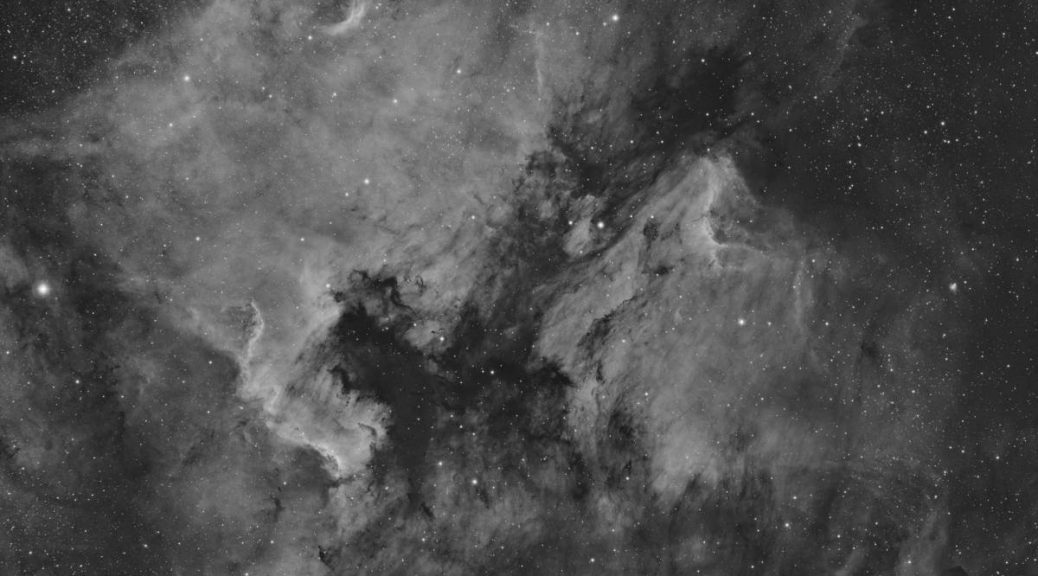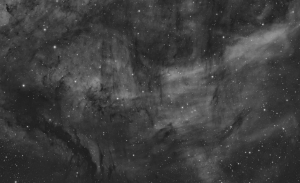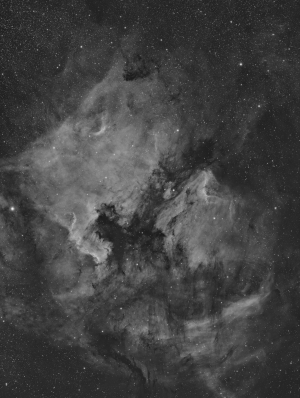 The North America nebula is a remarkably shaped area of emission nebula in the constellation of Cyngus, just to the west of the blue-white supergiant Deneb (α Cyg – just out of shot to the right) – it’s name coming from the clear resemblance to the continent – even down to the gulf of Mexico. It is accompanied by the Pelican Nebula (IC5070), another emission region located between NGC7000 and Deneb.
The North America nebula is a remarkably shaped area of emission nebula in the constellation of Cyngus, just to the west of the blue-white supergiant Deneb (α Cyg – just out of shot to the right) – it’s name coming from the clear resemblance to the continent – even down to the gulf of Mexico. It is accompanied by the Pelican Nebula (IC5070), another emission region located between NGC7000 and Deneb.
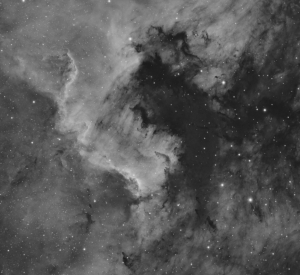 The whole nebula is formed out of one cloud of gas, with a dark band of dust between the two blocking light from behind and giving the resultant shapes.
The whole nebula is formed out of one cloud of gas, with a dark band of dust between the two blocking light from behind and giving the resultant shapes.
There are several areas of star formation in the nebulae – particularly along the region known as “The Wall” in NGC7000, and in the Pelican (and just visible on this image) a Herbig-Haro object (HH555) which shows two jets associated with a newly born star.
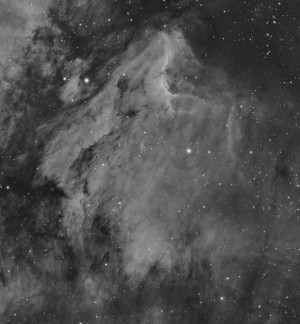 This can been seen in the 100% scale close up of IC5070, just to the right of the “eye” – the Herbig Haro object is at the end of the dark dust protrusion.
This can been seen in the 100% scale close up of IC5070, just to the right of the “eye” – the Herbig Haro object is at the end of the dark dust protrusion.
Just to the south of both the larger areas of nebulosity is a fainter region of gas which has a really interesting pattern of overlaid dust which forms streaks of darkness across the bright nebula, almost appearing to cross at right angles.
There are no definitive distances for this region of nebulosity on the sky, though if the gas is largely excited by Deneb, it would place the region at around 1600 light years distant with a size of about 100 light years. From earth, the total field of view is over 10 full moons across on the longest side.
The image was taken using a new camera and lens combination – a QHY163M camera at -15C with a Canon 200mm f2.8L II lens (stepped down to f3.85 with a 52mm step ring). Mount was a Losmandy GM8, and total 5h56m in 2min sub exposures through a Baader 7nm H-Alpha filter. The camera was run at gain 200, offset 104, and all image capture used Sequence Generator Pro. Images were processed using Pixinsight.
Data captured between 3rd and 8th Aug 2018 from Cassagnabère-Tournas, France.
Field centred at:
RA: 20h 54m 56s
Dec: +44° 14′ 42″
Field size (overall image) 3.96 x 5.26 deg, Up is 355 degrees E of N
![]() North America and Pelican Nebulae by Graeme Coates is licensed under a Creative Commons Attribution-NonCommercial-ShareAlike 4.0 International License.
North America and Pelican Nebulae by Graeme Coates is licensed under a Creative Commons Attribution-NonCommercial-ShareAlike 4.0 International License.
